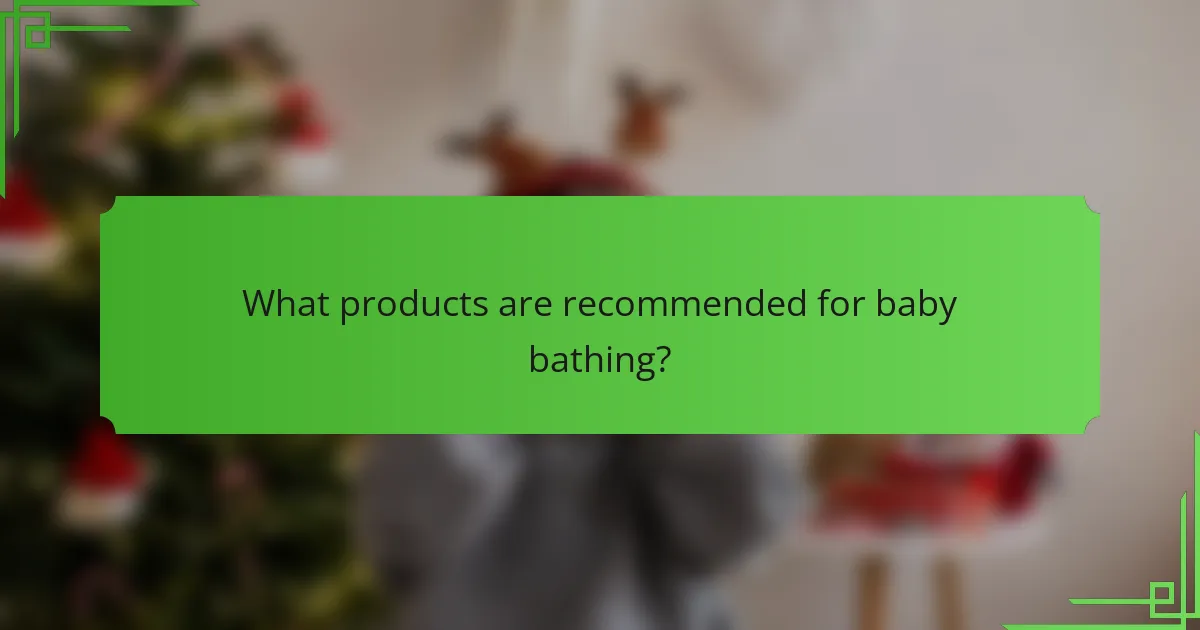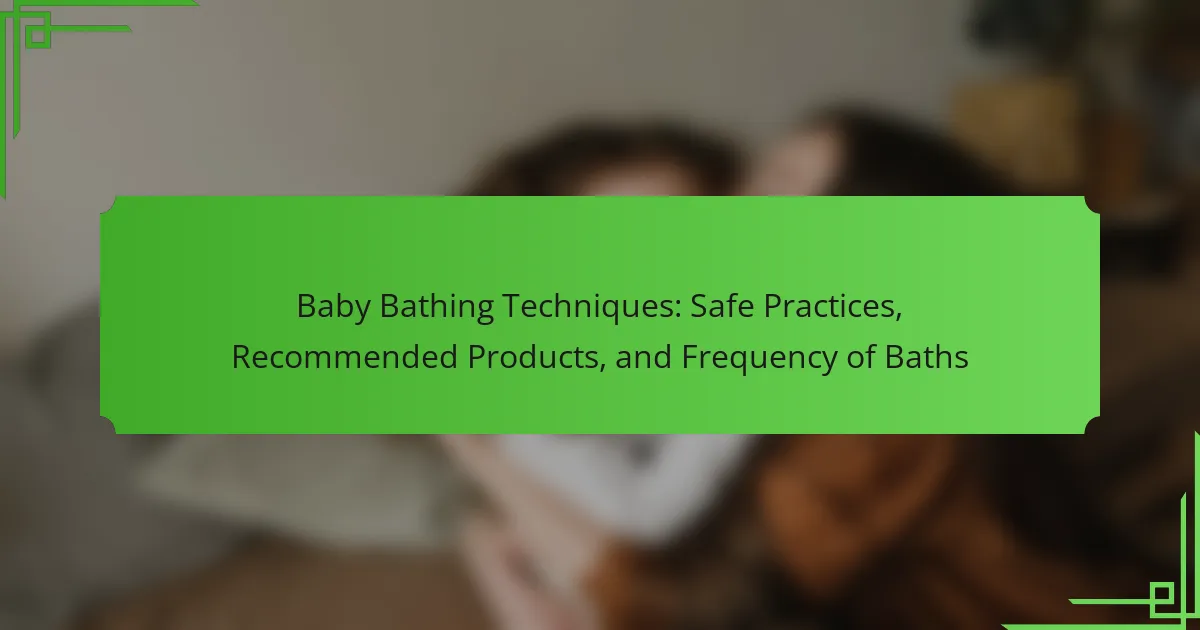Baby bathing techniques focus on safety, comfort, and skin health for infants. Key practices include ensuring the water temperature is between 37-38 degrees Celsius (98.6-100.4 degrees Fahrenheit), using gentle washing methods, and supporting the baby’s head and neck during the bath. Recommended products for safe bathing include baby bathtubs, soft washcloths, gentle soap, bath thermometers, and non-slip mats. It is advised to bathe newborns two to three times a week to avoid skin irritation, as frequent bathing can dry out their sensitive skin. Spot cleaning is often sufficient until the umbilical cord falls off, after which regular baths can begin.

What are the essential baby bathing techniques?
Essential baby bathing techniques include ensuring safety, using proper water temperature, and employing gentle washing methods. Always support the baby’s head and neck during the bath. Use a non-slip surface to prevent accidents. The water temperature should be around 37-38 degrees Celsius (98.6-100.4 degrees Fahrenheit) for comfort. Use mild, fragrance-free soap to avoid skin irritation. Rinse thoroughly to remove soap residue. Bathing should be done in a calm environment to soothe the baby. It’s recommended to bathe newborns two to three times a week to maintain skin health.
How can parents ensure a safe bathing environment for their baby?
Parents can ensure a safe bathing environment for their baby by following specific safety measures. Always supervise the baby during bath time to prevent drowning. Use a non-slip mat in the bathtub to avoid slips and falls. Ensure the water temperature is between 90°F and 100°F to prevent burns. Never leave the baby unattended, even for a moment. Keep all bathing supplies within reach to avoid leaning over the tub. Use a baby bath seat if necessary, but do not rely on it completely. Regularly check the water level to ensure it is appropriate for the baby’s size. Following these guidelines significantly reduces the risk of accidents during bath time.
What safety measures should be taken before starting a bath?
Ensure the bathing area is safe and free from hazards. Remove any sharp objects or slippery mats. Check the water temperature to avoid burns, ideally between 90°F and 100°F. Always have a non-slip mat in the tub to prevent slipping. Keep all necessary bathing supplies within reach to avoid leaving the baby unattended. Use a bath seat or support if needed for stability. Never leave a baby alone in the bath, even for a moment. These measures help prevent accidents and ensure a safe bathing experience for infants.
How can parents prevent slips and falls during bath time?
Parents can prevent slips and falls during bath time by using non-slip mats in the tub. These mats provide a stable surface for children to stand on. Additionally, parents should always supervise their children while bathing. This constant oversight can help quickly address any unsafe situations. Using a bath seat can also provide extra support for younger children. Ensuring the water temperature is comfortable prevents sudden movements that could lead to slips. Lastly, keeping bath toys organized reduces clutter, minimizing tripping hazards. According to the National Safety Council, falls are a leading cause of injury among children, highlighting the importance of these preventive measures.
What are the recommended bathing practices for newborns?
Newborns should be bathed two to three times a week. This frequency helps to maintain their delicate skin without causing dryness. Use a soft washcloth and lukewarm water for bathing. Avoid submerging the newborn in water until the umbilical cord stump falls off. Instead, opt for sponge baths during the first few weeks. Ensure that the bathing area is warm to prevent chilling. Always keep one hand on the baby for safety. After bathing, gently pat the skin dry and apply a mild moisturizer if needed. These practices help promote hygiene while protecting the newborn’s sensitive skin.
How often should newborns be bathed?
Newborns should be bathed two to three times a week. Frequent bathing can dry out their sensitive skin. It’s important to use a gentle cleanser designed for infants. The American Academy of Pediatrics recommends sponge baths until the umbilical cord stump falls off. After that, parents can transition to tub baths. Bathing too often can lead to skin irritation. Therefore, a regular schedule of two to three baths weekly is sufficient for hygiene and comfort.
What techniques are best for bathing a newborn safely?
The best techniques for bathing a newborn safely include sponge baths and tub baths. Sponge baths are recommended until the umbilical cord stump falls off. Use a soft washcloth and warm water for gentle cleaning. Ensure the room is warm to prevent chilling. When transitioning to a tub bath, use a small baby tub or a clean sink. Always support the baby’s head and neck during the bath. Keep one hand on the baby at all times to ensure safety. Use mild, fragrance-free baby soap to avoid skin irritation. Rinse thoroughly to remove all soap residue. These practices help prevent accidents and ensure a comfortable bathing experience for the newborn.
What are the best practices for bathing older babies?
The best practices for bathing older babies include ensuring safety, maintaining hygiene, and using appropriate products. Always supervise the baby during bath time to prevent slips and accidents. Use a non-slip mat to provide stability in the tub. Fill the tub with only a few inches of warm water, ideally around 100°F (37.8°C). Test the water temperature with your wrist before placing the baby in the tub. Use mild, fragrance-free soap to avoid skin irritation. Gently wash the baby, starting from the face and moving to the rest of the body. Rinse thoroughly to remove soap residue. After bathing, wrap the baby in a warm towel to keep them comfortable. Regular bathing is recommended about two to three times a week, depending on the baby’s activity level and skin condition. Following these practices helps ensure a safe and enjoyable bathing experience for older babies.
How can parents transition from sponge baths to tub baths?
Parents can transition from sponge baths to tub baths by gradually introducing their baby to a larger bathing environment. Start by filling the tub with a small amount of warm water, ensuring it’s shallow enough for safety. Use a non-slip mat to prevent slipping. Hold the baby securely while gently lowering them into the tub. Keep the baby’s head above water to ensure comfort and safety. Use a soft washcloth to wash the baby, making it a fun experience with toys. Gradually increase the water level as the baby becomes more comfortable. This method eases the baby into the tub bath experience, promoting relaxation.
What are the recommended techniques for washing an older baby?
To wash an older baby, use a gentle approach with safe techniques. Gather all necessary supplies before starting, including a soft washcloth, baby soap, and a towel. Ensure the bathing area is warm and free of drafts. Fill the tub or basin with a few inches of warm water, testing the temperature with your wrist. Support the baby securely with one hand while using the other to wash. Start by gently cleaning the face and move down to the body. Rinse thoroughly to remove soap, avoiding the baby’s eyes. After washing, wrap the baby in a towel to keep them warm. These techniques ensure the baby’s safety and comfort during bath time.

What products are recommended for baby bathing?
Recommended products for baby bathing include baby bathtubs, soft washcloths, and gentle baby soap. Baby bathtubs provide a safe and secure environment for bathing infants. Soft washcloths are gentle on a baby’s sensitive skin. Gentle baby soap is formulated to be mild and tear-free. Additionally, a bath thermometer can help ensure the water temperature is safe. Hooded towels keep babies warm and comfortable after bathing. Non-slip mats can prevent slipping during bath time. These products enhance safety and comfort during the bathing process.
What types of baby bath products are essential?
Essential baby bath products include baby soap, baby shampoo, and bath towels. Baby soap is formulated to be gentle on sensitive skin. It helps to cleanse without causing irritation. Baby shampoo is designed to be tear-free. This ensures a comfortable bathing experience for infants. Bath towels are necessary for drying the baby after a bath. They should be soft and absorbent to protect the baby’s delicate skin. Additionally, a baby bath tub can provide a safe bathing environment. These products collectively contribute to a safe and pleasant bathing routine for infants.
Which soaps and shampoos are safe for babies?
Gentle, tear-free soaps and shampoos are safe for babies. Products labeled as hypoallergenic and free of sulfates and parabens are ideal. Brands like Cetaphil Baby, Johnson’s Baby, and Aveeno Baby offer such options. These products are formulated to minimize irritation on sensitive skin. Pediatricians recommend using mild cleansers specifically designed for infants. Always check for certifications like dermatologically tested or pediatrician-approved. Additionally, avoid fragrances and dyes to reduce the risk of allergic reactions.
What bath accessories should parents consider using?
Parents should consider using a non-slip bath mat for safety. A non-slip mat reduces the risk of slipping during bath time. Bath toys can also enhance the bathing experience. They keep babies entertained and engaged. A soft washcloth is essential for gentle cleaning. It protects the baby’s sensitive skin. A baby bath thermometer ensures the water temperature is safe. The ideal temperature is around 100°F (37.8°C). A bath seat provides support for infants. It allows parents to have hands-free bathing. Finally, a hooded towel helps keep babies warm after the bath. These accessories contribute to a safer and more enjoyable bathing routine.
How can parents choose the right bathing products?
Parents can choose the right bathing products by considering several key factors. First, they should select products specifically formulated for babies. These products are typically free from harsh chemicals and fragrances. Parents should also look for hypoallergenic options to minimize the risk of skin irritation. Checking for pediatrician recommendations can provide additional assurance of safety. Additionally, parents should consider the product’s pH balance, ideally selecting those that are pH-balanced to match a baby’s sensitive skin. Reading labels for certifications, such as dermatologically tested or organic, can also guide choices. Lastly, parents can seek reviews from other parents to gauge product effectiveness and safety.
What ingredients should be avoided in baby bath products?
Ingredients to avoid in baby bath products include sulfates, parabens, and artificial fragrances. Sulfates can irritate sensitive skin and strip natural oils. Parabens are preservatives linked to hormonal disruptions. Artificial fragrances may cause allergic reactions or skin irritation. Additionally, avoid phthalates, which are associated with reproductive issues. Alcohol can also be drying and irritating to delicate skin. Always choose products labeled as hypoallergenic and free from these harmful ingredients.
How can parents identify hypoallergenic options?
Parents can identify hypoallergenic options by looking for products labeled as hypoallergenic. These products are formulated to minimize the risk of allergic reactions. Ingredients in hypoallergenic products are typically less likely to irritate sensitive skin. Parents should check for certifications from dermatological or allergy associations. Reading ingredient lists is essential to avoid common allergens. Products with fewer synthetic fragrances and dyes are often safer. Testing a small amount on the skin before full use can help assess tolerance. Consulting pediatricians for recommendations can provide additional guidance.

How often should babies be bathed?
Babies should be bathed about two to three times a week. Frequent bathing can dry out their sensitive skin. According to the American Academy of Pediatrics, bathing too often may lead to skin irritation. Newborns do not need daily baths, as they are not very mobile and do not get dirty. Spot cleaning with a washcloth is often sufficient. After the umbilical cord falls off, parents can start giving more regular baths. Always ensure the bath water is warm but not hot to prevent burns.
What factors influence the frequency of baby baths?
The frequency of baby baths is influenced by several factors. These include the baby’s age, skin type, and activity level. Newborns typically require fewer baths, around two to three times a week. As babies grow and become more active, their bathing frequency may increase. Skin type also plays a crucial role; babies with dry skin may need less frequent baths to avoid irritation. Environmental factors, such as climate and season, can affect how often a baby should be bathed. Additionally, cultural practices and parental preferences can influence bathing routines. For example, some cultures may prioritize daily baths, while others may suggest less frequent bathing.
How does a baby’s age affect bathing frequency?
A baby’s age significantly influences bathing frequency. Newborns typically require less frequent baths, about two to three times a week. Their skin is sensitive and can dry out easily. As babies grow, usually around six months, they may need more regular baths due to increased mobility and messiness. Older infants, who are more active, often benefit from daily baths. This helps to maintain hygiene as they explore their environment. Pediatric guidelines support these practices, emphasizing skin health and safety.
What are the signs that a baby needs a bath?
A baby needs a bath when they show signs of dirt or odor. Visible dirt on the skin indicates that a bath is necessary. An unpleasant smell can also signal that it’s time for a bath. If the baby has been sweating or drooling excessively, a bath may be needed. Additionally, if the baby’s diaper area appears soiled, this is a clear sign. Bathing helps maintain hygiene and comfort for the baby. Regular baths can prevent skin irritation and rashes.
What are the recommendations for bathing frequency in different situations?
Recommendations for bathing frequency vary by situation. For newborns, bathing is recommended 2-3 times a week. This frequency helps maintain skin moisture. For older infants, daily baths may be suitable if they enjoy it. Active toddlers may require more frequent baths due to play. In hot weather, increased bathing can prevent overheating. After meals or messy activities, a bath is advisable. Skin conditions may necessitate specific bathing routines. Always consult a pediatrician for personalized advice.
How should bathing frequency change during warmer weather?
During warmer weather, bathing frequency should generally increase. Higher temperatures can lead to increased sweating and dirt accumulation. Babies may need baths more often to stay clean and comfortable. It is advisable to bathe them at least every other day in hot weather. This helps prevent skin irritation and rashes caused by sweat. Parents should monitor their baby’s skin condition closely. If the skin appears irritated, more frequent bathing may be necessary. Additionally, using mild soap can help maintain skin moisture.
What is the impact of skin conditions on bathing frequency?
Skin conditions significantly affect bathing frequency. Conditions like eczema or psoriasis can lead to skin irritation. Frequent bathing may worsen these conditions by stripping natural oils. Conversely, some conditions may require more frequent bathing to manage symptoms. For example, bacterial infections may necessitate daily baths. Dermatologists often recommend tailored routines based on individual skin conditions. Proper moisturizing after bathing is crucial for maintaining skin health. Studies indicate that a balanced approach minimizes flare-ups and maintains skin integrity.
What tips can help make bath time enjoyable for babies?
To make bath time enjoyable for babies, create a warm and safe environment. Ensure the water temperature is comfortable, ideally between 90°F to 100°F. Use gentle, baby-friendly bath products to avoid skin irritation. Introduce bath toys to engage the baby’s interest and make the experience fun. Sing songs or play soothing music to create a calming atmosphere. Keep bath time short to prevent overwhelming the baby, ideally around 5 to 10 minutes. Always stay within arm’s reach to ensure safety during the bath. These practices help foster positive associations with bath time.
Baby bathing techniques encompass essential practices that ensure safety, hygiene, and comfort for infants during bath time. Key topics include safety measures such as using non-slip mats and maintaining appropriate water temperatures, as well as recommended bathing frequencies for newborns and older babies. The article also highlights the importance of selecting gentle, hypoallergenic products and offers tips for making bath time enjoyable. By following these guidelines, parents can create a safe and pleasant bathing experience for their children, promoting skin health and hygiene.
